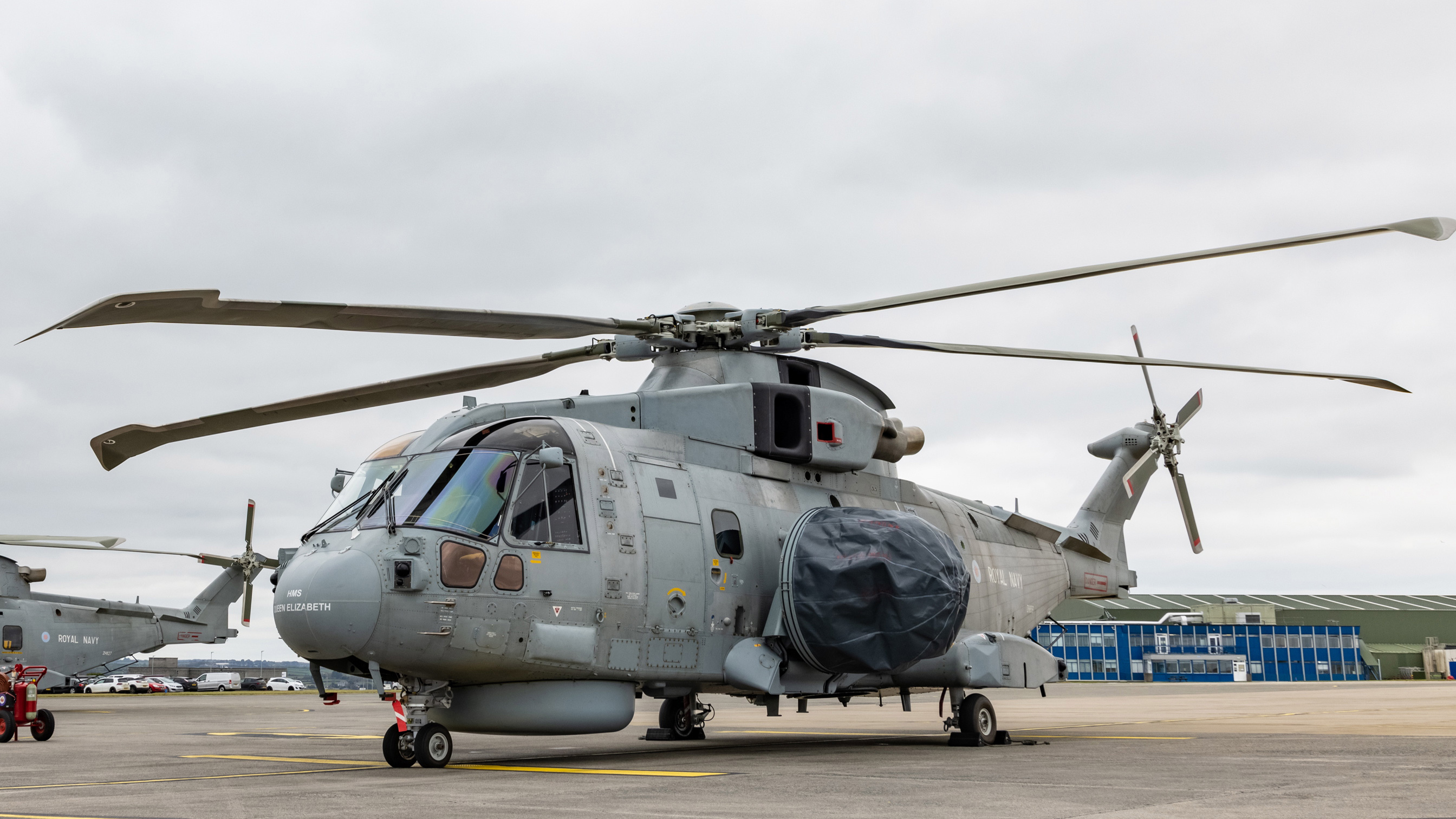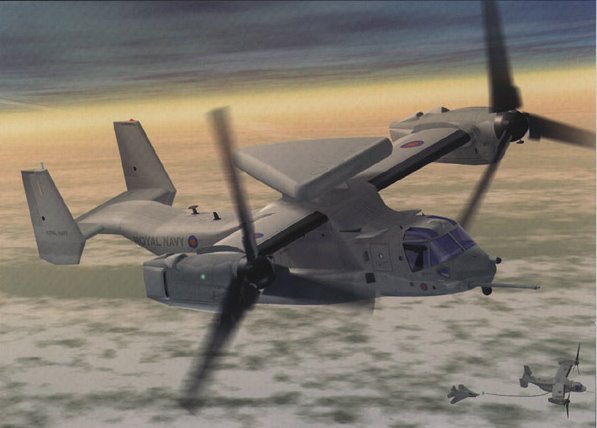The U.K. Royal Navy recently announced that the first Merlin Crowsnest carrier-based airborne early warning helicopter had been delivered to its home base, at Culdrose in Cornwall, ahead of a scheduled first operational cruise aboard the HMS Queen Elizabeth later this spring, bringing a powerful new surveillance capability to the fleet. But the Crowsnest concept could have been altogether very different, had the U.K. decided on a more advanced — and more costly — active electronically scanned array (AESA) radar setup.
With the primary task of long-range air, sea, and land surveillance, a radar helicopter, like Crowsnest, is a vital component of the U.K.’s resurgent carrier strike capability, providing a way to detect, identify, and track threats beyond an armada’s horizon, ensuring that it’s protected.

The Royal Navy had gone for years without any carriers at all after the retirement of HMS Ark Royal, together with all of the country’s short takeoff and vertical landing (STOVL) Harrier GR9s, as a result of the 2010 Strategic Defense and Security Review. Now, a multi-billion-dollar project has reinstated what the U.K. Ministry of Defense describes as the Carrier Enabled Power Projection (CEPP) capability, and Crowsnest is central to this. As well as the two Queen Elizabeth class aircraft carriers themselves, and at least 48 F-35B Lightning Joint Strike Fighters, around $329 million is being spent on Crowsnest.
Delivery of the first aircraft to the operating unit means the Royal Navy is, once again, ready to take an airborne early warning (AEW) helicopter to sea. While the current Crowsnest will be an eagerly awaited and critical addition to the carrier strike group, it might not have been the best solution in terms of overall capability.
Overall, the path to get to this point has been a fairly tortuous one. It’s been an incredible 21 years since what was then known as the Future Organic Airborne Early Warning program was announced in the U.K. parliament. At that point, it was anticipated that the resulting capability could be in service by 2012.
Before settling on the current Crowsnest solution, the U.K. had considered an active electronically scanned array (AESA) array which, as also seen in the photo at the top of this story, was installed in pods along the lower fuselage sides of the Merlin.

Known as Vigilance, this was a Lockheed Martin offering and it incorporated technology derived from the Northrop Grumman AN/APG-81 used in the F-35 Joint Strike Fighter. At some point later on, Lockheed switched from the AN/APG-81-derived radar to the Israeli Elta EL/M-2052 radar, again contained within side-mounted pods. The same containers, which attached to the Merlin’s existing torpedo hardpoints, also carried identification friend or foe (IFF) and electronic support measures (ESM) equipment.
Either way, once equipped, this AEW Merlin would have benefited from all the advantages of an AESA radar, chiefly its ability to rapidly scan huge volumes of airspace compared to older radars that use a mechanically-steered dish. AESAs also offer increased detection and tracking ranges compared to similarly-sized mechanically-scanned designs. They have improved target discrimination and identification capabilities, especially when it comes to spotting low-flying targets with small radar cross-sections, such as cruise missiles or drones. Clearly, such a capability is hugely important when it comes to protecting a carrier group.
Lockheed Martin began testing the Vigilance system in late 2011 and flight trials were conducted using a Merlin test aircraft at MOD Boscombe Down, in southwest England, the U.K. military aircraft testing establishment. There are next to no details available of what this testing achieved, but it’s clear it was part of a so-called assessment phase to compare the different available options.
Thought was also been given to a bespoke AEW aircraft based on the V-22 Osprey tiltrotor, which would have offered greater endurance and a higher operating altitude than the Merlin. The V-22 has long been eyed as a potentially highly useful, if expensive, addition to the Royal Navy’s future carrier strike groups, also being able to provide carrier onboard delivery, aerial refueling, combat search and rescue, and other missions.

Helicopter AEW platforms are, by their nature, limited by their operating altitude, which reduces their radar reach, and by their range, as well as being more fatiguing for their operators. All those drawbacks would have been addressed by the U.S. Navy’s E-2D Advanced Hawkeye, one other platform that was under consideration. However, this would only have been feasible if the U.K. had opted to equip its carriers with catapults for launching aircraft and arrester wires for recovering them. While a “cats and traps” configuration was briefly the plan, as you can read about here, the final choice fell on a STOVL carrier, tailored around the F-35B.
While the Osprey and Advanced Hawkeye were likely never realistic propositions, on cost grounds, the Ministry of Defense spent many years — and a reported $49 million — weighing up the options.

In the background, meanwhile, defense firm Thales offered a less ambitious and cheaper adaptation of the existing Searchwater 2000 and Cerberus used in what was then the Royal Navy’s radar helicopter, the Sea King ASaC7. This had first entered Royal Navy service in 1982 as an urgent response to the lack of AEW coverage during the Falklands War and the original Searchwater technology dated back to the latter half of the 1970s.
In April 2015, Lockheed Martin teamed up with Thales to pitch this offering as an alternative to Vigilance. The following month, the U.K. Ministry of Defense selected the Lockheed/Thales proposal. The decision had cost millions of pounds and years of development work, to end up with what was, essentially, the same equipment already in use, ported over to a helicopter that was also well established in service.
In November 2016, a contract was agreed with Lockheed Martin UK to provide and integrate 10 Crowsnest systems as roll-on/roll-off kits for the existing fleet of 30 Merlin HMA2 anti-submarine warfare helicopters, all of which are being adapted to accommodate the equipment. In the process, 200 jobs were secured across the United Kingdom, with Lockheed Martin, as well as sub-contractors Thales and Leonardo Helicopters.

Today’s Crowsnest system essentially utilizes the same Searchwater 2000 radar and Cerberus tactical sensor suite that were both used in the long-serving Sea King ASaC7, the last of which were retired in September 2018, after nearly 40 years of service. As in the Sea King, the mechanically scanned radar antenna is carried in an inflatable bag that pivots down from the side of the helicopter. The appearance of this installation led to the “Baggers” nickname for the helicopter and its operators, who, like the equipment, have also been passed from the Sea King ASaC7 to the Merlin Crowsnest.
Up to 600 contacts can be monitored by the Cerberus suite, including airborne threats as well as small, fast-moving targets over land and water. The ability to provide overland surveillance is something that was exploited by the Sea King ASaC7 over Afghanistan, in particular, where the aircraft were used successfully in support of NATO forces on the ground.

As a mechanically scanned system, the Searchwater 2000 not only falls short in terms of capabilities compared to an AESA equivalent but also has increased maintenance demands, with more moving parts compared to a conformal AESA system. A potential failure of the pivoting arm, for instance, would prevent the helicopter from undertaking its mission and the spinning dish also needs constant upkeep.
That said, some improvements have been made to the equipment for the new Crowsnest application and these reportedly address the human interface, target identification capability, and resilience against electronic jamming.
Above all, however, the Crowsnest system was chosen by the U.K. Ministry of Defense as it was judged the more affordable one, and one which should have presented a minimum risk. Selecting the same equipment as used in the Sea King ASaC7, even if it is “warmed over,” should also reduce the demands on training and logistics.

As it was, despite choosing what was considered the lower-risk solution, the Crowsnest program ended up delayed anyway. Originally anticipated to enter operational service in 2018, coinciding with the withdrawal of the Sea King ASaC7, it wasn’t until March 2019 that a Merlin HM2 fitted with Crowsnest took to the air for the first time.
A revised initial operating capability (IOC) date was then planned for December 2020, to align with the declaration of IOC for HMS Queen Elizabeth in the carrier strike role. This called for one carrier “fitted with the Crowsnest radar system, with supporting infrastructure, logistics, communications and surveillance in place.”

However, a report last June from the U.K. Government’s National Audit Office, which scrutinizes public spending, noted that “the initial contracted capability will not be available until September 2021, 18 months later than planned.”
“The Department did not oversee its contract with Lockheed Martin effectively and, despite earlier problems on the project, neither was aware of the subcontractor’s lack of progress until it was too late to meet the target delivery date,” the report continued. “It subsequently concluded that the subcontractor working on the project, Thales, failed to meet its contractual commitments to develop the equipment and had not provided sufficient information on the project’s progress. The Department and its industry partners have since implemented a recovery plan and enhanced monitoring arrangements.”
Delays have continued, however, and a “full airborne radar capability” for Crowsnest is now not expected until May 2023.
Meanwhile, for the forthcoming Carrier Strike Group 21 (CSG21) deployment to the Mediterranean and the Indo-Pacific — the first operational cruise for HMS Queen Elizabeth — nine Merlin HM2s from 820 Naval Air Squadron (NAS) are expected to go onboard. Of these, three are likely to be equipped with the pre-IOC Crowsnest kits. Taking maintenance and training requirements into account, that leaves precious few airframes for anti-submarine warfare.
Once that first carrier deployment is complete, we may have a better idea of how well this ‘renewed’ iteration of the Crowsnest performs. It could well be that the Royal Navy has a worthy successor to the Sea King ASaC7 in the making, or it might even come to regret turning down the more advanced AESA solution from Lockheed Martin.
Contact the author: thomas@thedrive.com
